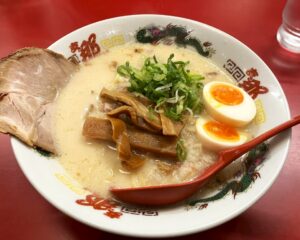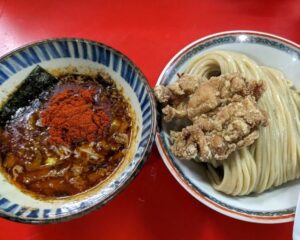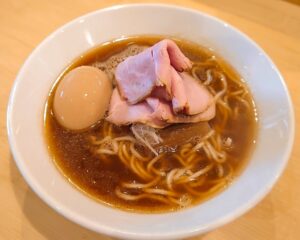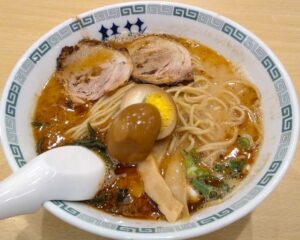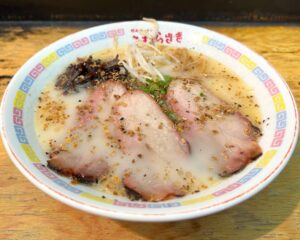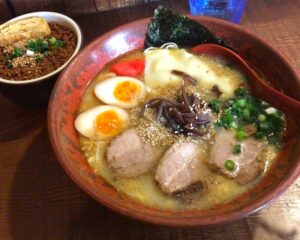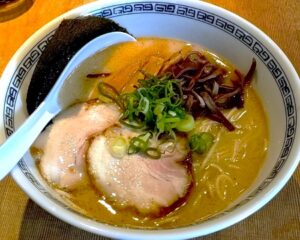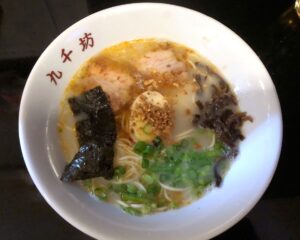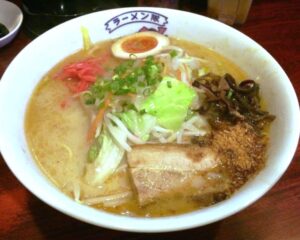Kumamoto Ramen (Kumamoto Pref.)
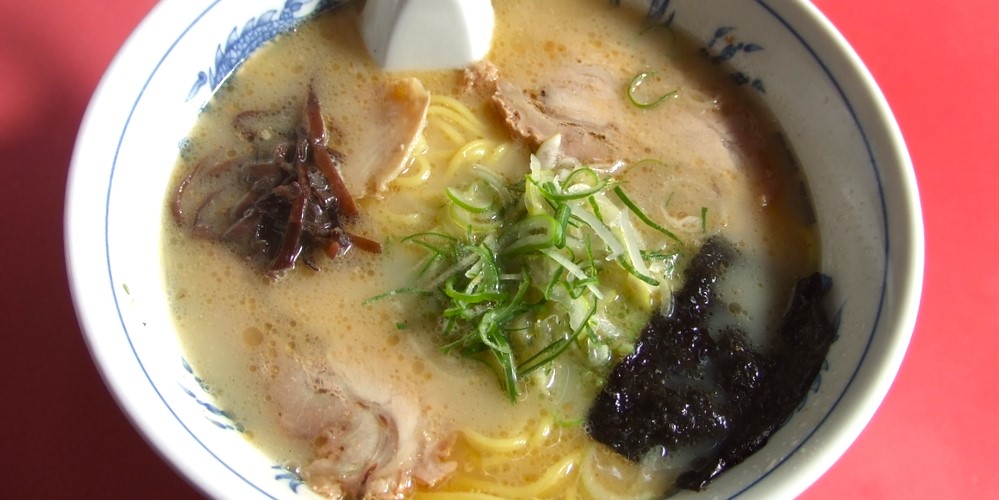
What is Kumamoto Ramen(熊本ラーメン)?
Ramen spread from Kurume City, Fukuoka Prefecture, the birthplace of tonkotsu ramen, to Tamana City(玉名市), Kumamoto Prefecture, and then to Kumamoto City and its surrounding areas. Compared to Tamana ramen and Hakata ramen (Nagahama ramen), thicker noodles are used, and chicken bones are added to the soup. Unlike Hakata and Tamana, which use raw garlic, cooked garlic (chips and scented oil made with garlic) is used.
The biggest difference between Kurume ramen and Tamana ramen is that the soup is used up on the same day(取り切り Torikiri style), rather than the Kurume style of replenishing soup(呼び戻し Yobimodoshi style).
The noodles tend to be medium-thick straight noodles with low water content and boiled until slightly firm.
While Hakata uses pickled red ginger as an ingredient, wood ear fungus is more commonly used as an ingredient.
For the toppong ingredient, Hakata uses pickled red ginger(紅生姜 Benishouga), while wood ear mushroom strips are more commonly used.
Why “fried garlic (マー油 Ma-yu oil)”?
Kumamoto also has cloudy tonkotsu ramen, which is common in Kyushu, but the noodles are straight low-hydration noodles and are thicker than Hakata’s, and the soup is made with tonkotsu and chicken bones, making it rich but mild. What makes it different is that it is flavored with cooked garlic.
There are many different ways to use garlic depending on the ramen shops. “桂花 Keika” uses Ma-yu(マー油) garlic oil, “Komurasaki(こむらさき)” uses garlic chips, and “Ajisen(味千)” uses fried garlic. What’s really interesting is that the three shops that represent Kumamoto use the same garlic in different ways.
The original roots of Kumamoto Ramen are “Sankyu(三九)” (founded in 1952) in Tamana City, Kumamoto Prefecture. It follows the style of Kurume ramen and does not contain garlic at this point. This is a method devised by the late Koji Shigemitsu (重光孝治 formerly known as 劉壇祥 Liu Danxiang), the founder of Ajisen(味千), who was originally from Taiwan and was well versed in cooking, in order to add impact to the soup. This was also spread to other shops.
Today, the fried garlic oil known as Ma-yu(マー油) oil is said to be inspired by the seasoning oil used in Hakka cuisine, which is used in noodle dishes in the Kaohsiung area of southern Taiwan, where Shigemitsu is from. When written in kanji, 魔油; it means “magic oil”.
“Shouyouken(松葉軒),” “Komurasaki(こむらさき),” and “Keika(桂花)” opened, followed by “Ajisen(味千).”
Hajime Kimura(木村一), Yasutoshi Yamanaka(山中安敏), and Liu Danxiang (劉壇祥 later changed their name to Koji Shigemitsu 重光孝治), who came from Kumamoto City after hearing the rumors about Sankyu(三九), were impressed by the taste of Sankyu, and Kimura decided to open Shouyouken(松葉軒), Yamanaka opened “Komurasaki(こむらさき),” and Ryu/Shigemitsu worked as a cook at “Keika(桂花),” founded by Satsuki Hisatomi(久富サツキ), before opening “Ajisen(味千),” which is considered the originator of Kumamoto ramen. Chronological history of the founding of long-established Kumamoto Ramen
| Year of foundation | Shop name, founder and events |
|---|---|
| 1953 | Shouyouken(松葉軒/Hajime Kimura木村一) *Ended its 65-year history in 2018. |
| 1954 | Komurasaki (こむらさき/Yasutoshi Yamanaka山中安敏) *Opened under the name of the popular Kagoshima shop “Komurasaki.” |
| 1954 | Kodaiko Ramen (こだいこラーメン formerly Toyoken/Murata Minetoshi村田峰年) *2016 Earthquake → Kitchen truck reopened → Shop revived. The daughter inherited the pure pork bone soup. |
| 1955 | Keika Ramen(桂花ラーメン/Satsuki Hisatomi久富サツキ) *Civil rehabilitation due to poor management in 2010.Shigemitsu Sangyo; Ajisen Ramen, had helped its revitalization and revived. |
| 1957 | Koku Tei (黒亭 Takeyoshi Hirabayashi平林武良) *A disciple of Komurasaki Yamanaka. Started a ramen shop as a side job as a painter. |
| 1968 | Ajisen Ramen (味千ラーメン/ Liu Danshiong劉壇祥/Koji Shigemitsu重光孝治) *There are many in mainland China and they are famous, but there are currently no shops in the Kanto region, so many Japanese people do not know about them. |
Komurasaki, Keika, and Ajisen all have Taiwanese-style ramen, and use boiled eggs seasoned in a Taiwanese style. Also, in Hakata, it is common to add pickled red ginger, but in Kumamoto, it is common to add wood ear mushroom strips. It is different from Hakata in that there are no Kaedama; another helping of noodles, and if you want more volume, you have to order a large portion. (Currently, due to the influx and fusion of cultures, some places use Kaedama.)
“Keika” expanded into Tokyo, “Komurasaki” opened a shop at the “Shin-Yokohama Ramen Museum” and spread the word about Kumamoto ramen, and “Ajisen” expanded into China and became a global chain shop. (Approximate number as of April 2024: 68 shops in Japan / 560 shops in China / 60 shops in other areas)
These three shops played a central role in the development of Kumamoto ramen, but just like in Hakata, new types of ramen are appearing in historic Kumamoto.
“Bunryu(文龍)” from Furaiken (風来軒/Miyazaki Prefecture) is popular for its rich tonkotsu soy sauce and a different type of ramen. Although it is a relatively new shop that opened in 2008, it has gained momentum and currently has about 3 shops. Daikinton(大金豚) used to serve tonkotsu seafood tsukemen inspired by Rokurinsha (六厘舎/Tokyo), but it closed in 2019. The shop changed its name to TATARABA and now serves seafood pork bones ramen and tsukemen, and Kumamoto ramen. In addition, Daikinboshi(大金星), which was separated from Daikinton(大金豚), now forms the “Gyorai Group(魚雷グループ)” and becomes popular. It has also expanded into Tokyo, leveraging its spiciness and seafood soup stock. In addition, for non-tonkotsu ramen, “Men Shounin(麺商人)”, which uses a variety of dried fish, became popular and was even included in the Michelin Guide.
“Hokuyuu(北熊)”, whose name refers to Hokkaido and Kumamoto, has a different soup and noodles from these Kumamoto ramen, with homemade curly noodles in a soup made with chicken bones and vegetables. You can also enjoy light soy sauce flavored ramen here.
In Hitoyoshi City, which is far from the prefectural capital, there is “Haorai(好来)” (founded in 1958), where Mr. Ichiro Furuya(古谷一郎) of “Nantsuttei(なんつッ亭)” trained. In fact, Mr. Naoki Takada(高田直樹), the owner of Hakata’s famous shop Hakata Shinpu (博多新風/Fukuoka Prefecture), also came from Haorai. “Haorai(好来)” was originally a famous shop for “Ma-yu Tonkotsu”, which is well known to ramen connoisseurs, but the popularity of “Hakata Shinpu”, which is currently a hot topic, is increasing, and it is gaining attention as a must-have shop in Kumamoto.
Ramen-Japan / Examples of Ramen Shops
Examples of the long-established Kumamoto ramen shops
-
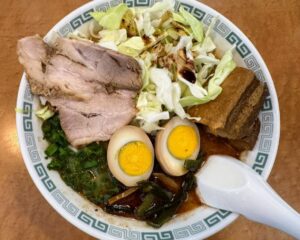
-
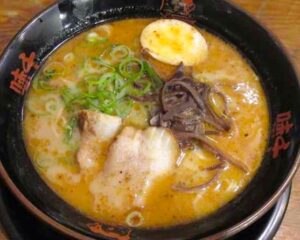
-
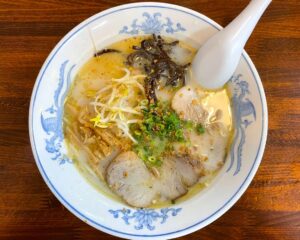
Komurasaki Kamidori Chuo branch(こむらさき 上通中央店) *Famous for its garlic chips.
-
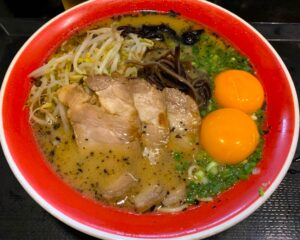
Kokutei Main Shop(黒亭 本店) *Egg ramen is popular. Kurotei was created because the founder liked black.
-
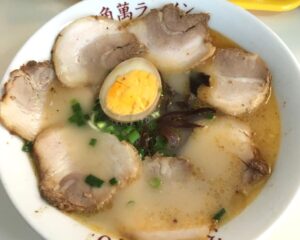
Ramen Kadoman(ラーメン 角萬) *Old-fashioned Kumamoto ramen is “Kadoman Ramen”
-
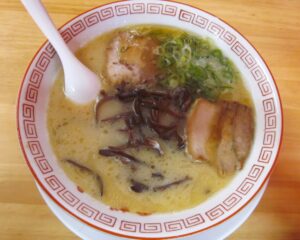
Original Kumamoto Ramen Kodaiko(元祖熊本ラーメン こだいこ) *Shop in a bright red container house
Examples of popular Kumamoto ramen shops
-
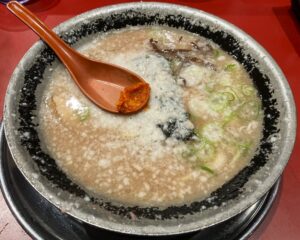
Hi no Kuni Bunryu Main Shop(火の国文龍 総本店) *Super rich pork bones. It’s also sold on Amazon.
-
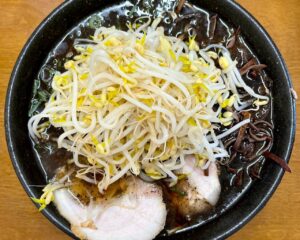
Haorai Ramen(好来ラーメン) *A jet black soup that uses a lot of melon oil.
-
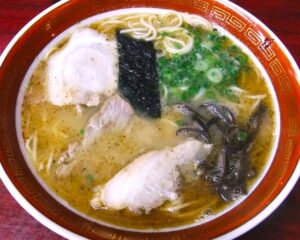
Daikoku Ramen(大黒ラーメン) *Trained at Kokutei. Many autographs from famous people.
-
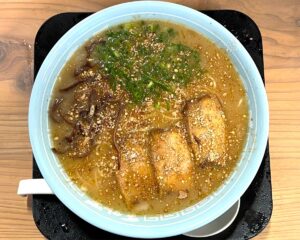
Tengaiten(天外天) *Large amount of garlic powder and garlic pickled in soy sauce free of charge.
-
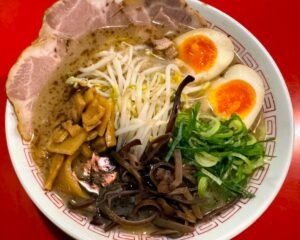
Ramen Akagumi(ラーメン赤組) *A popular shop located in the downtown area.
-
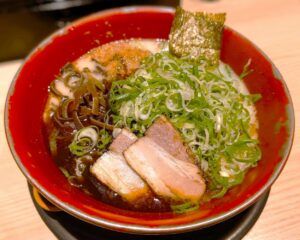
Traditional Kumamoto Tonkotsu Den Main Shop(伝統熊本豚骨 伝 総本店) *Ajisen Ramen affiliated shop.

